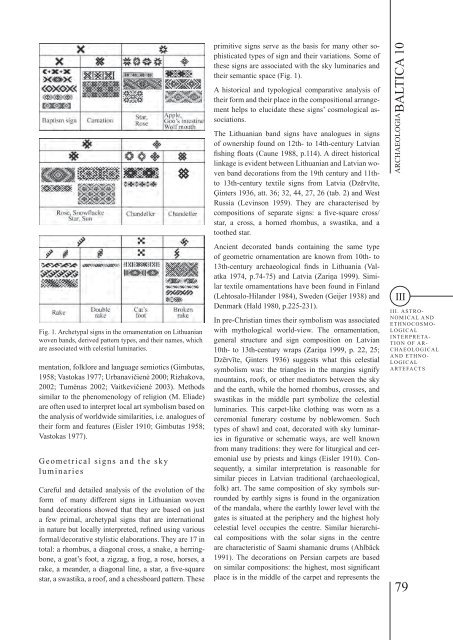BALTICA10
BALTICA10
BALTICA10
Create successful ePaper yourself
Turn your PDF publications into a flip-book with our unique Google optimized e-Paper software.
Fig. 1. Archetypal signs in the ornamentation on Lithuanian<br />
woven bands, derived pattern types, and their names, which<br />
are associated with celestial luminaries.<br />
mentation, folklore and language semiotics (Gimbutas,<br />
1958; Vastokas 1977; Urbanavičienė 2000; Rizhakova,<br />
2002; Tumėnas 2002; Vaitkevičienė 2003). Methods<br />
similar to the phenomenology of religion (M. Eliade)<br />
are often used to interpret local art symbolism based on<br />
the analysis of worldwide similarities, i.e. analogues of<br />
their form and features (Eisler 1910; Gimbutas 1958;<br />
Vastokas 1977).<br />
Geometrical signs and the sky<br />
luminaries<br />
Careful and detailed analysis of the evolution of the<br />
form of many different signs in Lithuanian woven<br />
band decorations showed that they are based on just<br />
a few primal, archetypal signs that are international<br />
in nature but locally interpreted, refined using various<br />
formal/decorative stylistic elaborations. They are 17 in<br />
total: a rhombus, a diagonal cross, a snake, a herringbone,<br />
a goat’s foot, a zigzag, a frog, a rose, horses, a<br />
rake, a meander, a diagonal line, a star, a five-square<br />
star, a swastika, a roof, and a chessboard pattern. These<br />
primitive signs serve as the basis for many other sophisticated<br />
types of sign and their variations. Some of<br />
these signs are associated with the sky luminaries and<br />
their semantic space (Fig. 1).<br />
A historical and typological comparative analysis of<br />
their form and their place in the compositional arrangement<br />
helps to elucidate these signs’ cosmological associations.<br />
The Lithuanian band signs have analogues in signs<br />
of ownership found on 12th- to 14th-century Latvian<br />
fishing floats (Caune 1988, p.114). A direct historical<br />
linkage is evident between Lithuanian and Latvian woven<br />
band decorations from the 19th century and 11thto<br />
13th-century textile signs from Latvia (Dzērvīte,<br />
Ģinters 1936, att. 36; 32, 44, 27, 26 (tab. 2) and West<br />
Russia (Levinson 1959). They are characterised by<br />
compositions of separate signs: a five-square cross/<br />
star, a cross, a horned rhombus, a swastika, and a<br />
toothed star.<br />
Ancient decorated bands containing the same type<br />
of geometric ornamentation are known from 10th- to<br />
13th-century archaeological finds in Lithuania (Valatka<br />
1974, p.74-75) and Latvia (Zariņa 1999). Similar<br />
textile ornamentations have been found in Finland<br />
(Lehtosalo-Hilander 1984), Sweden (Geijer 1938) and<br />
Denmark (Hald 1980, p.225-231).<br />
In pre-Christian times their symbolism was associated<br />
with mythological world-view. The ornamentation,<br />
general structure and sign composition on Latvian<br />
10th- to 13th-century wraps (Zariņa 1999, p. 22, 25;<br />
Dzērvīte, Ģinters 1936) suggests what this celestial<br />
symbolism was: the triangles in the margins signify<br />
mountains, roofs, or other mediators between the sky<br />
and the earth, while the horned rhombus, crosses, and<br />
swastikas in the middle part symbolize the celestial<br />
luminaries. This carpet-like clothing was worn as a<br />
ceremonial funerary costume by noblewomen. Such<br />
types of shawl and coat, decorated with sky luminaries<br />
in figurative or schematic ways, are well known<br />
from many traditions: they were for liturgical and ceremonial<br />
use by priests and kings (Eisler 1910). Consequently,<br />
a similar interpretation is reasonable for<br />
similar pieces in Latvian traditional (archaeological,<br />
folk) art. The same composition of sky symbols surrounded<br />
by earthly signs is found in the organization<br />
of the mandala, where the earthly lower level with the<br />
gates is situated at the periphery and the highest holy<br />
celestial level occupies the centre. Similar hierarchical<br />
compositions with the solar signs in the centre<br />
are characteristic of Saami shamanic drums (Ahlbäck<br />
1991). The decorations on Persian carpets are based<br />
on similar compositions: the highest, most significant<br />
place is in the middle of the carpet and represents the<br />
ARCHAEOLOGIA BALTICA 10<br />
III<br />
III. ASTRO-<br />
NOMICAL AND<br />
ETHNOCOSMO-<br />
LOGICAL<br />
INTERPRETA-<br />
TION OF AR-<br />
CHAEOLOGICAL<br />
AND ETHNO-<br />
LOGICAL<br />
ARTEFACTS<br />
79
















